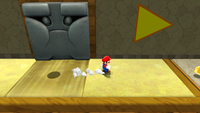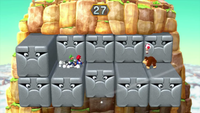Bomp
Template:Species-infobox Bomps are Thwomp relatives that first appeared in Super Mario 64. They are living, pushing, protruding stones that act as obstacles in many games. Their name is a portmanteau of "bump" and "Thwomp."
History
Super Mario series
Super Mario 64 / Super Mario 64 DS
Bomps made their first appearance in Super Mario 64 and its Nintendo DS remake, Super Mario 64 DS; herein, they are known as Moving Bars.[1] The first type, also known as Pushy Walls,[2] appears in the course Whomp's Fortress. At the beginning of the course, they go through a pattern of pushing, trying to shove Mario off a cliff, and subsequently making him fall down the course's pit. The beginning and end Moving Bars are thinner and faster than the center one. Their eyes have a blue outline with blue pupils, and a thick black outline along the tops. An eyeless, mechanical type of Moving Bar appears in Tick Tock Clock. They have a spring-like recoil unlike the previous ones. Like the other pieces of the clock, they are affected by how Mario enters the clock and are used as platforms as well as obstacles. Objects similar to Moving Bars also appear as platforms in Bowser in the Dark World and Bowser in the Sky, although they again have slightly different sliding behavior.
In Super Mario 64 DS, no Moving Bars have eyes, and their moving patterns have been altered to appear more in unison. The Moving Bars in Whomp's Fortress can also be destroyed if hit by a character powered up by a mushroom.
Super Mario Galaxy
Bomps reappear in Super Mario Galaxy, where they now more closely resemble Thwomps. They appear in the Buoy Base Galaxy and the Freezeflame Galaxy. Similar objects also appear as part of the Cyclone Stone.
Super Mario Galaxy 2
In Super Mario Galaxy 2, they appear with the same role and appearance as in Super Mario Galaxy. They appear in the Fluffy Bluff Galaxy and the Throwback Galaxy, the latter which is a remake of Whomp's Fortress. In the Fluffy Bluff Galaxy, Bomps can assist the player in climbing the slope where they are located, but in the Throwback Galaxy, their purpose is more like that of an obstacle. Like before, similar objects appear in Stone Cyclone Galaxy.
Paper Mario: Sticker Star

Bomps make an appearance in Paper Mario: Sticker Star in the Chomp Ruins, retaining their appearance in Super Mario Galaxy. In the game, they are made of cardboard instead of stone. They come out from waterfalls and double doors. An upside-down Bomp appears as a scrap, and it must be flipped over using paperization so that Mario can reach the Ruin Floor scrap.
Mario Party 10
Bomps made their Mario Party series debut in Mario Party 10 in the minigame Cliffside Crisis, where they serve as both obstacles and platforms for the players.
Names in other languages
| Language | Name | Meaning |
|---|---|---|
| Japanese | つきだし[3] Tsukidashi にょっきり壁[4] Nyokkiri Kabe Tsukidashikun[5] (internal) ツキダシドン[6][7] Tsukidashidon |
Protrusion (Super Mario 64, general) Protruding Wall (Super Mario 64, Whomp's Fortress) Protrusion-kun (Super Mario Galaxy) Protrusion Thud (since Super Mario Galaxy) |
| Chinese (simplified) | 突面墩 Tūmiàn Dūn |
Protrusion Stone Block |
| Chinese (traditional) | 凸臉機關石 Tūliǎn Jīguān Shí |
Protrusion Mechanism Stone |
| German | Schubswand |
Nudge wall |
| Italian | Bomp |
- |
| Russian | Бомп Bomp |
Bomp |
| Spanish (NOA) | Don Empujón |
Mr. Pusher |
| Spanish (NOE) | Pujón Don Empujón (Enciclopedia Super Mario Bros.) |
From "empujón" (push) Mr. Pusher |
Trivia
- In Super Mario Galaxy, Bomps are two-sided; their model appears on the other side of the wall they are on too.[8] In-game, this is only visible with a few pairs in the Freezeflame Galaxy.
- In Dreamy Mount Pajamaja in Mario & Luigi: Dream Team, there are stone hands that act similarly to Bomps. The Push-Blocks of Super Mario Odyssey also act like them.
References
- ^ Timed Jumps on Moving Bars
- ^ M. Arakawa. Super Mario 64 Player's Guide. Page 25.
- ^ Shogakukan. 2015. Super Mario Bros. Hyakka: Nintendo Kōshiki Guidebook, Super Mario 64 section, page 92.
- ^ Super Mario 64 Japanese character info book
- ^ Super Mario Galaxy / Super Mario Galaxy 2 internal filename (Tsukidashikun)
- ^ Shogakukan. 2015. Super Mario Bros. Hyakka: Nintendo Kōshiki Guidebook, Super Mario Galaxy section, page 127.
- ^ Shogakukan. 2015. Super Mario Bros. Hyakka: Nintendo Kōshiki Guidebook, Super Mario Galaxy 2 section, page 160.
- ^ https://twitter.com/MarioBrothBlog/status/1319729639691046914?ref_src=twsrc%5Egoogle%7Ctwcamp%5Eserp%7Ctwgr%5Etweet
| Thwomps | ||
|---|---|---|
| Characters | Akuiwagumi (leader) • Chō Dossun • Gattai monster • Head Thwomp • Mr. Thwomp • Mrs. Thwomp • Sphinx Zō • Thwomp Bros. • Thwomp Elevator | |
| Species | Grindels | Grindel • Spindel |
| Pouncers | Omodon • Pouncer | |
| Miscellaneous | Big Thwomp • Bone Thwomp • Karamenbo • Mega Thwomp • Security Thwomp • Shoomp • Sniffle Thwomp • Spiked Thwomp • Star Thwomp • Stone Elevator • Tail Thwomp • Thwimp • Thwomp • Thwomp Platform | |
| Relatives | Grrrols | Grrrol • Mega Grrrol |
| Ka-thunks | Ka-thunk • King Ka-thunk | |
| Konks | Big Konk • Konk | |
| Spiny Tromps | Spiky Tromp • Spiny Tromp | |
| Thwacks | Thwack • Thwack Totem • Wonder Thwack | |
| Wallops | Wallop • Walleye | |
| Whomps | Big Whomp • Whimp • Whomp • Whomp King | |
| Other | Bomp • Flomp • Grumblump • Rhomp • Stairface Ogre • Stone-Eye • Tox Box • Tsuboshi • Walking Block | |



